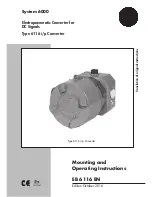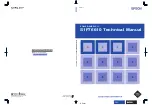
E5 Series High Performance Universal Inverter User’s Manual
94
Chapter 6 Parameter Descriptions
The larger the Kp value setting, the faster the response, but if the Kp value is too large, vibration may
occur, and the deviation cannot be eliminated completely only by Kp.
It can use Ki to eliminate the residual deviation. The larger the Ki value setting, the faster the response to
the deviation change, but if the Ki value is too large, vibration may occur.
If the system has frequent jump feedback, it needs to use Kd because Kd can respond to the deviation
change between the system feedback and the reference quickly. The larger the Kd value setting, the
faster the response is, but if the Kd value is too large, vibration may occur.
This function is used to set the sampling cycle of the feedback signal. The lower this parameter value is,
the faster system response to the deviation between the reference and the feedback, but if the sampling
cycle is too fast, the associate requirement for the system PID regulation will be higher, which may result
in system vibration.
When this function determines the certain level of the deviation between the feedback signal and the
reference signal, it will stop the internal PID regulation and maintain stable output. Only when the
deviation between the feedback value and the reference value of the close loop exceeds the deviation
limit of P8.07, the output will be updated. Setting the deviation limit needs to take the system control
precision and stability into consideration.
This parameter is used to set the integral property during the process close loop regulation.
P8.08 PID integral property
Ones place
Integral mode:
0: Stop integral regulation after the running frequency
reaches the upper or lower limit
T: Continue integral regulation after the running frequency
reaches the upper or lower limit
Tens place
Output frequency
0: Must be consistent with preset direction
T: Can regulation to reverse to preset direction
If the output value of the close loop regulation reaches frequency upper limit or lower limit (P0.T3 or
P0.T4), there are two actions for integration selection.
0: Stop integral regulation: the integral value remains unchanged. When there is change occurring to the
deviation between the reference value and the feedback value, the integration value will follow that
change trend.
T: Continue integral regulation: The integration value will immediately respond to the change between
the reference value and the feedback value unless this value reaches the internal integral limit.
When there is change occurring to the deviation between the reference value and the feedback value
00 ~ TT(00)
PID integral property
P8.08
0.0 ~ T0.0 % (5.0%)
PID deviation limit
P8.07
0.00T ~ 30.000 s (0.00Ts)
Sampling cycle
P8.06
0.000 ~ T0.000(0.000)
Derivative gain Kd
P8.05
0.000 ~ T0.000(0.500)
Integral gain Ki
P8.04
0.000 ~ T0.000(0.T00)
Proportional gain Kp
P8.03
Summary of Contents for E5 Series
Page 1: ...E5 Series High Performance Universal Inverter USER S MANUAL E5 Series USER S MANUAL ...
Page 7: ...vi T Setting Process for Open Loop ...
Page 8: ...vii Open loop setting process continued ...
Page 9: ...viii 3 Setting Process for Closed Loop ...
Page 10: ...ix Setting Process for Closed Loop continued ...
















































